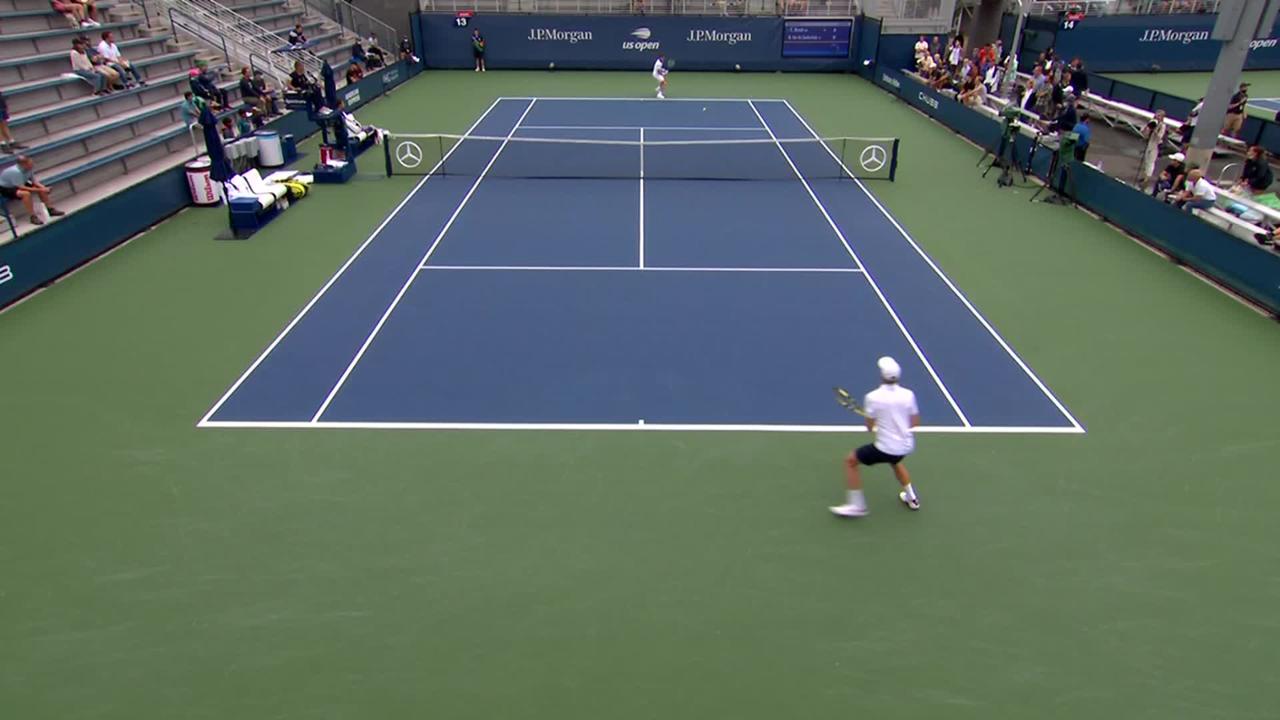Trivia: After Novak Djokovic, who has won the most singles matches at Grand Slam tournaments this year? Counting qualifying rounds (and why not?), it’s a three-way tie at 15 wins between ATP World No. 2 Daniil Medvedev, World No. 8 Matteo Berrettini—and World No. 117 Botic van de Zandschulp.
The outlier is a 25-year-old Dutch qualifier who is playing far above his ranking. In New York, he has been the comeback king, losing the first set (or two) in each match of his five so far. He took out No. 8 seed Casper Ruud in the second round.
The secret? A steady accumulation of confidence and positivity throughout the year. Van de Zandschulp qualified for all four Slams and has topped them off with four main-draw wins (and counting—today, he plays No. 80 qualifier Argentine Facundo Bagnis, who has a mere one Slam win this year).
Van de Zandschulp burnished those tennis-grunt credentials with a marquee main-draw win over No. 20 Hubert Hurkacz in the first round of the French Open, coming back from two sets to love down. At the time, Hurkacz, the newly minted 2021 Miami champion, was in the midst of a six-match losing streak, but his semifinal run at Wimbledon a few weeks later made the upset look a lot better. Hurkacz lost the semi to Matteo Berrettini, whose second-round victim was...van de Zandschulp.
It sounds like tennis is a small world. But van de Zandschulp has played in 13 countries so far this year while grinding out a 36-17 record, mostly on the ATP Challenger Tour. That’s a 68% winning rate this year, which would put him at No. 11 on the ATP leaderboard (right behind John Isner), if Challengers counted. Along the way, he has beaten No. 40 Reilly Opelka at the Great Ocean Road Open in Melbourne and given No. 20 Karen Khachanov a 7-6, 5-7, 3-6 fight in the semifinal. Not bad for van de Zandschulp’s first tour-level event.
He should have arrived in New York tired. After Wimbledon, he played five ATP Challenger tournaments in five consecutive weeks in five different European countries. He went deep in each: one final, three semifinals, and one quarterfinal.
But any fatigue is balanced out by confidence right now. That’s the upside of winning 15 matches in 30 days.
Van de Zandschulp has also worked on his positivity, which has come in handy in New York. In qualifying, he lost the first set in all three matches. In his first main-draw match, he lost the first two. In the second round against Ruud, he dropped the first set by double-faulting on break point twice. But he doesn’t pay much attention to the scoreboard.
“When I play best of five and I lose the first two and win the third, I have the feeling that I’m already tied with the other guy. I have the momentum, I am the upper player at the moment,” he said. “[Against Ruud], I had the feeling that I was leading the match while it was one set all and on serve in the second for a long time.”
“He is very relaxed, on and off court,” said Tim Colijn, a reporter for the Netherlands’ largest news agency, ANP. “It looks like he is never impressed by something or somebody, which is a big quality for a tennis player. If he plays against Ruud, for example, he really believes he can win the match.”
On top of that, the forehand is a serious weapon. “Botic has one of the best swings of the tour,” Colijn said. “His forehand is so loose and fluid. He can accelerate so easily because of his loose wrist. [Former World No. 1 doubles player] Jacco Eltingh said that he will get out of the way when Botic hits a forehand. Also, with his service, he can find all the angles very easily as he is very agile.”
Colijn describes van de Zandschulp’s style as big-man tennis without the big-man body (he’s 6-foot-3). He saved all 10 break points against Ruud after the first set—and gets everything back. Then he can use his forehand to go from defense to offense quickly. He also has the composure to jar an opponent with a drop shot or soft angle out of nowhere.
So where did the aristocratically named van de Zandschulp come from? His origin story is pretty standard. He grew up in Wageningen, spending a lot of time at a tennis club where his mother and older brother played recreationally. He wasn’t a distinguished junior player, but did well in Futures events and felt good about his prospects. “I knew once I got into the Challengers, it could go fast and then I could play qualifying for the Grand Slams,” he said.
Colijn says the new National Training Centre in Amstelveen was a big boost to van de Zandschulp. “It was perfect for him,” Colijn said. “The facilities are great, and [Dutch tennis] approached a lot of quality coaches. He was able to travel a lot with a coach the last couple of years. Before he was not.” Right now, his team situation is in flux. A former coach, Michiel Schapers, is in New York with him. Earlier this year, he was working with former Dutch pro Peter Lucassen, who until recently was a coach for the USTA’s development program.
Don’t be surprised to see van de Zandschulp in the fourth round—he won’t be surprised. “I think I can go further in the tournament if I play like today,” he told the ATP after beating Ruud. “That’s what I’m focused on. For me, it’s not the end of the tournament if I make the third round. That’s now how I’m [thinking].”
Don’t be surprised if he pulls off another comeback, either.


